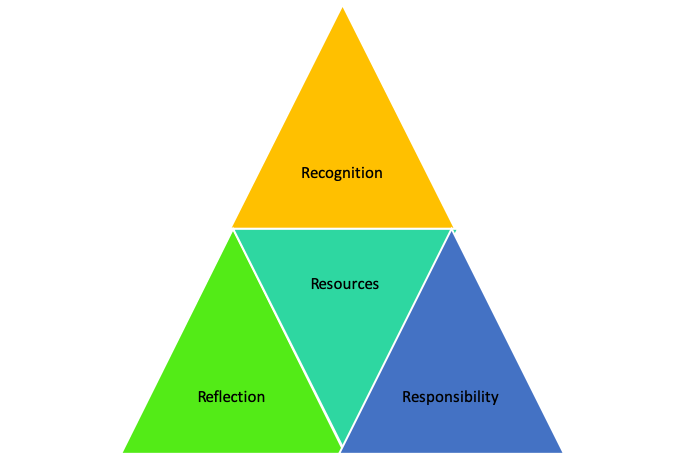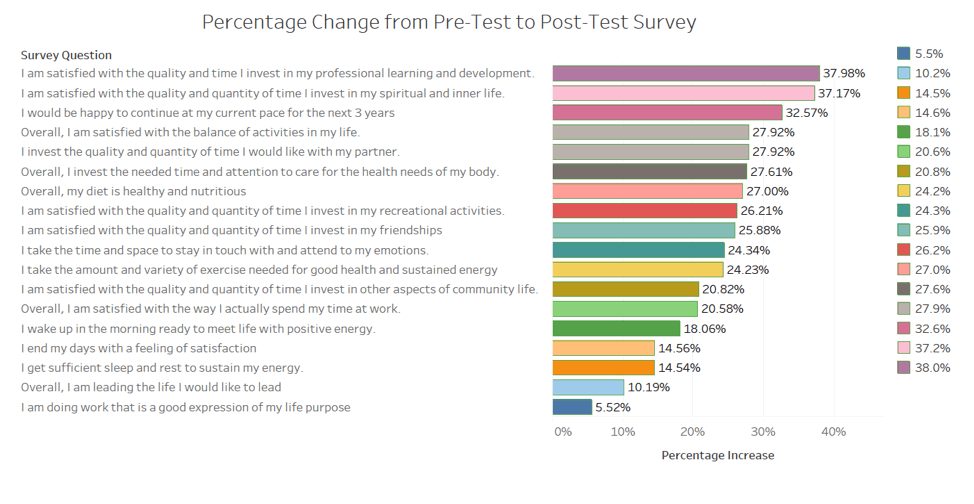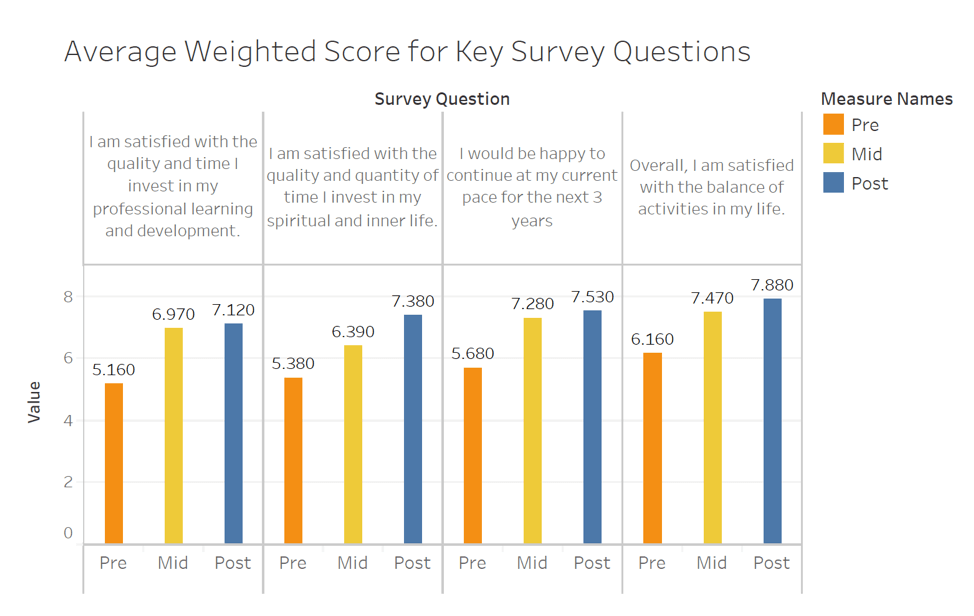
I recently spent time with one of my “she-roes” in the movement, Ana Maria Archila. On the morning she and I met, she had already driven through midtown New York City traffic to do school drop-offs and fixed a flat tire. The week after our meeting, I saw her on national news facing down a US Senator in a Capitol Hill elevator. Ana Maria, like many of us women in the movement, juggles so much before she even gets to work.
At times, I have sacrificed so much of myself for my work that I have had little energy left to pour into the rest of my life. Because many of us in the social change movement do work that is so central to our personal missions, it can be hard to negotiate the boundaries. That’s why I am so committed to Family-Work Integration as a tool for helping women succeed at work.
Our organization’s “family-work integration” program builds on the research findings of Dr. Stacy Blake-Beard of Simmons College. A year ago, we adopted this approach at Faith in Action (formerly PICO). We asked everyone on our national staff team to commit to no meetings and no emails on Fridays. We close our offices and create space for our staff to re-energize, plan, read, write, and think. The Family-Work Integration Plan has been a pilot investment in the creativity and development of our staff.
The Family-Work Integration Plan is grounded in my belief that in order to be successful at work, women of color need four things:

- Room for Reflection,
- Responsibility,
- Resources, and
- Recognition.
So often, outside the workplace, women carry outsized caregiving responsibilities. We tend to shortchange our own time for reflection and receiving recognition. Who has energy to read before going to bed when you’ve never stopped during the day? Who can take another trip to accept the speaking engagement when your aging parent needs help? Many of us have been role-trained by family and cultural dynamics to be “responsible and responsive.” So, when there’s work to be done, we often make the leadership mistake of being the first person to grab a mop. People around us (both at work and at home) catch on quickly and then we find ourselves weighted down in situations that limit our creativity and imagination. We carry too much responsibility, without the commensurate resources, recognition, and space for reflection. We get the job done, but at tremendous cost to our psyches and our families.
Over time, I have come to learn that Family-Work Integration is not only possible, it is essential to our success as women of color in leadership. In order to have greater impact, we need more room to reflect.
The Family-Work Integration Plan is a targeted universalist approach to retaining and growing talented staff, a structural change that encourages staff to get better by dedicating 20 percent of their time to growing their creativity and learning. It is designed to include, improve, and ignite the leadership of women of color in our workplace.
We started by including women of color. We chose a targeted universalist approach to achieving equity, based on the research of Dr. john powell. The easiest way to think about it is to think about curb-cuts in the sidewalks. For whom are curb-cuts designed? They’re designed for people who use wheelchairs, right? But who uses them? Everyone benefits from them, but they’re designed for a specific group of people. That’s targeted universalism. The Family-Work Integration Plan is focused on retaining and growing women of color with the understanding that in a workplace where women of color thrive, everyone thrives.
Our organization had been having trouble retaining extremely talented Black and Latina women. As I watched so many phenomenal women come and go, I decided to use my experience being the first Latina—first woman period—to have a family and pursue a long-term career in our network. I used my position as Chief of Staff to initiate a structural approach to growing the skill and creativity of all our staff by focusing on what women of color need.
The second element of the Family-Work Integration Plan is focused on improving. It provides space for staff to get better at their work. In a TED talk by Eduardo Briceño entitled “How to get better at the things you care about,” he describes how Beyoncé is arguably one of the most successful entertainers of our time, yet she is always seeking to improve. Every night after her show, before going home, she watches a video of her performance and send notes to her dancers, team members, and others with suggested changes.
The third part of our focus is on igniting the creativity of our people. Most people at work spend 100 percent of their time executing their job. Our staff now have 20 percent of their time to be more creative. Imagine being a concert pianist, never practicing, only performing. Yet, that’s what we do in business. Our staff, probably like your staff, are often so busy attending meetings and conference calls, answering phone calls, and responding to emails that they are not unleashing their full creativity on the important challenges we face.
The Family-Work Integration Plan is structured as follows. Monday through Thursday are about execution of your job. Friday is a paid workday set aside for growing your creativity and improving your skills. Our offices are all closed on Fridays—people mostly work from home or another convenient location. Organization-wide, we have committed to no meetings and no emails on Fridays. Each person is responsible for their own creativity and learning, in partnership with their manager. Finally, the program applies to all staff, regardless of seniority in the organization.
The Process of Shifting Our Culture
Embedded deeply in the world of social change lives a mindset of urgency. Of course, when our communities are under attack by harsh policies, that is urgent. At the same time, not everything we do needs to be urgent. Some things can be planned out in advance. In a national staff retreat, we identified that the #1 cultural challenge we needed to address was our organizational “culture of urgency.” We have learned that a culture of urgency is one characteristic of institutions that have a white supremacy culture. We reflected on how this almost-manic need to stay busy was embedded not only in the world we live in, but also in our own institutions, and even in us. The Family-Work Integration Plan is designed to combat the culture of urgency by showing staff what it looks like to take intentional time that is unscheduled to breathe, plan, learn, and read.
Sign up for our free newsletters
Subscribe to NPQ's newsletters to have our top stories delivered directly to your inbox.
By signing up, you agree to our privacy policy and terms of use, and to receive messages from NPQ and our partners.
Next, we needed to get buy-in from a range of stakeholders in the organization. We created an interdisciplinary team of national staff led by Felicia Yoda to review the proposal and discuss it with all staff. The national staff leadership team put together guidelines for the plan and even generated an out-of-office email reply for all staff to use on Fridays. All staff committed to each other, face to face, that they would “try on” this experiment for a year. After the year was finished, we have continued this policy and lean further into this new cultural change.
The launch of the Family-Work Integration Plan reminds me of the first time my husband Julio and I went on a 20-mile bike ride together. We had been doing four-mile rides, 10-mile rides, but hadn’t tried 20 yet. When we got to the 10-mile mark, we were sure we had made a huge mistake. We turned around and wondered how in the world we’d make it all the way back to our starting point. When we got home from the ride, we both felt like we’d been run over.
Nowadays, we ride 20 miles every time we go out. So, what happened?
We built up with shorter rides. We got stronger; we built more cardio strength and muscle; we bought better equipment and found better routes. The same thing happened with the Family-Work Integration Plan. Some people embraced it more vigorously than others. Yet, over time, together we have grown stronger in the discipline of getting off the merry-go-round at the end of each week.
Once we started the experiment, I requested feedback individually from each staff member about how it was going. In the beginning, people were wrestling with shifting their work. In my assessment, it was senior staff who had the hardest time stopping the grind. One senior manager said after a couple of months, “I’ve only been able to take one Friday for Family-Work Integration so far.” I responded, “Well, then, it sounds like you’ve made some progress.” We celebrated even baby steps.
Encouraging Initial Research
Even though people are adopting the change to varying degrees, the initial results are encouraging. This targeted universalist structural change that helps people get better by setting aside structured time for creativity seems to be working.
When we launched the program, we administered an anonymous pre-test, midpoint, and a post-test to all national staff. Staff reported a 37-percent increase in their satisfaction with their own professional development and 32-percent rise in their satisfaction with the pace of the work. These two data points alone bode well for our future staff retention rates. We had not anticipated some of the other increases, such as improvements in diet and satisfaction with spiritual practice.


Scores went up in every single survey question, with an average score increase of 24 percent from pre-test to post-test. In addition to the quantitative survey questions, we asked staff more subjective questions along the way. Here are some of their responses:
- “It allowed me to spend more time with my father before he died than I would have had the Family-Work Integration Plan not been available.”
- “I learned that exhaustion is not a badge of glory. Staying in the office ’til 7:30–8:00 is a choice that I’m no longer willing to make, and a rested, clear-thinking, joy-filled version of myself is better for the organization, my career, and my family.”
- “I have learned it is a blessing to work for a company that prioritizes me and my family, and in return I am more productive.”
Many of the questions we asked are shown above and were adapted from a survey developed by the Rockwood Leadership Institute. Rockwood leads by example and has adopted a four-day workweek for its staff nationally. CNN recently reported on Perpetual Guardian, a company in New Zealand that tested out a plan to shift from a five-day work week to a four-day work week. The positive impact of the test is leading them to adopt the change permanently.
Next up in our pursuit of a more just and equitable workplace is to conduct research on how this refocusing of our work and emphasis on creativity is impacting our overall staff productivity. We are working now to identify a partner to conduct this research with us, so hit us up if you have ideas.
An Invitation to Invest in Reflection
During this first year of our Family-Work Integration pilot program, I have come to see how important reflection is for my own leadership as well. As part of the first year of the Family-Work Integration Plan, I read 20 books, wrote and published more articles, and often took long bike rides on Fridays. While it’s not my focus, I often find myself working through complex personal and work problems while seated on my bike. The extended quiet, the fresh air, sunshine, and physical exercise energize me. In just the way I’ve grown my physical stamina to ride longer, harder, and farther, I have grown my emotional elasticity and am finding better ways to deal with stressful situations.
We all need to create structures in our organizations that create space for staff, particularly female staff, for reflection. If we are serious about setting women of color up for success, we need to create institutional policy changes that ensure that they have equal doses of reflection, responsibility, resources, and recognition in their work.
We invite our colleagues in the social sector to try on Family-Work Integration with us. Imagine what would happen if we were all living into the fullest and truest expressions of ourselves. Imagine how our work will improve as we get closer to living wholehearted lives. Imagine drawing the boundaries that make us better people and better employees. The forces we are up against have money and power on their side. Imagine if a small increase in our creativity could tip the scales in favor of our families. Our families and communities deserve this kind of focus and clarity from those of us who lead the social justice field. The battles we fight are not only for today and tomorrow, they are the battles of a lifetime. Let’s be our most brilliant selves for today and forever.








